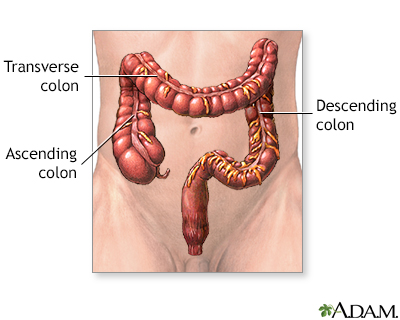Colitis
Colitis is swelling (inflammation) of the large intestine (colon).

Ulcerative colitis is categorized according to location. Proctitis involves only the rectum. Proctosigmoiditis affects the rectum and sigmoid colon. Left-sided colitis encompasses the entire left side of the large intestine. Pancolitis inflames the entire colon.

The large intestine is the portion of the digestive system most responsible for absorption of water from the indigestible residue of food. The ileocecal valve of the ileum (small intestine) passes material into the large intestine at the cecum. Material passes through the ascending, transverse, descending and sigmoid portions of the colon, and finally into the rectum. From the rectum, the waste is expelled from the body.

This lower abdominal X-ray shows narrowing (stenosis) of the end of the small intestine (ileum), caused by Crohn disease. Crohn disease typically affects the small intestine, whereas ulcerative colitis typically affects the large intestine. A solution containing a dye (barium), was swallowed by the patient. When it passed into the small intestines, this X-ray was taken (lower GI series).

Crohn disease, also called regional enteritis, is a chronic inflammation of the intestines which is usually confined to the terminal portion of the small intestine, the ileum. Ulcerative colitis is a similar inflammation of the colon, or large intestine. These and other IBDs (inflammatory bowel disease) have been linked with an increased risk of colorectal cancer.

The large intestine (colon) absorbs most of the fluid from foods.
Causes
Most of the time, the cause of colitis is not known.
Causes of colitis include:
- Infections caused by a virus or a parasite
- Food poisoning due to bacteria
- Crohn disease
- Ulcerative colitis
- Lack of blood flow to the colon (ischemic colitis)
- Past radiation to the colon (radiation colitis and strictures)
- Necrotizing enterocolitis in newborns
- Pseudomembranous colitis caused by Clostridium difficile infection (now called Clostridiodes difficile)
Symptoms
Symptoms can include:
- Abdominal pain and bloating that may be constant or come and go
- Bloody stools
- Constant urge to have a bowel movement (tenesmus)
- Dehydration
- Diarrhea
- Fever
Exams and Tests
The health care provider will perform a physical exam. You will also be asked questions about your symptoms, such as:
- How long have you had the symptoms?
- How severe is your pain?
- How often do you have pain and how long does it last?
- How often do you have diarrhea?
- Have you traveled recently?
- Have you taken antibiotics recently?
Your provider may recommend a flexible sigmoidoscopy or colonoscopy. During this test, a flexible tube is inserted through your rectum to examine your colon. You may have biopsies taken during this exam. Biopsies may show changes related to inflammation. This can help determine the cause of colitis.
Other studies that can identify colitis include:
Treatment
Your treatment will depend on the cause of the disease.
Outlook (Prognosis)
The outlook depends on the cause of the problem.
- Crohn disease is a chronic condition which has no cure but can be controlled. Biologic agents are very effective in controlling symptoms of Crohn colitis.
- Ulcerative colitis can usually be controlled with medicines. If not controlled, it can be cured by surgically removing the colon.
- Viral, bacterial, and parasitic colitis can be cured with appropriate medicines.
- Pseudomembranous colitis can usually be cured with appropriate antibiotics.
Possible Complications
Complications may include:
- Bleeding with bowel movements
- Perforation of the colon
- Toxic megacolon
- Sore (ulceration)
When to Contact a Medical Professional
Contact your provider if you have symptoms such as:
- Abdominal pain that does not get better
- Blood in the stool or stools that look black
- Diarrhea or vomiting that does not go away
- Swollen abdomen
References
Ananthakrishnan AN, Regueiro MD. Management of inflammatory bowel diseases. In: Feldman M, Friedman LS, Brandt LJ, eds. Sleisenger and Fordtran's Gastrointestinal and Liver Disease. 11th ed. Philadelphia, PA: Elsevier; 2021:chap 116.
Lichtenstein GR. Inflammatory bowel disease. In: Goldman L, Cooney KA, eds. Goldman-Cecil Medicine. 27th ed. Philadelphia, PA: Elsevier; 2024:chap 127.
Pardi DS, Cotter TG. Other diseases of the colon. In: Feldman M, Friedman LS, Brandt LJ, eds. Sleisenger and Fordtran's Gastrointestinal and Liver Disease. 11th ed. Philadelphia, PA: Elsevier; 2021:chap 128.
Version Info
Last reviewed on: 8/7/2023
Reviewed by: Michael M. Phillips, MD, Emeritus Professor of Medicine, The George Washington University School of Medicine, Washington, DC. Also reviewed by David C. Dugdale, MD, Medical Director, Brenda Conaway, Editorial Director, and the A.D.A.M. Editorial team.
